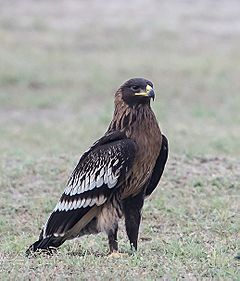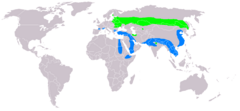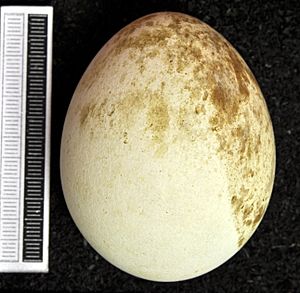Greater spotted eagle facts for kids
The greater spotted eagle (Aquila clanga) is a large bird of prey. Sometimes people just call it the spotted eagle. It's part of the Accipitridae family, which includes all true eagles. These eagles spend their summers in eastern Eurasia. When winter comes, they fly south to warmer places.
Quick facts for kids Greater spotted eagle |
|
|---|---|
 |
|
| Adult wintering at the Tal Chapar Wildlife Sanctuary (Rajasthan, India) | |
| Conservation status | |
| Scientific classification | |
| Kingdom: | |
| Class: | |
| Order: | |
| Family: | |
| Subfamily: |
Buteoninae
|
| Genus: |
Aquila
|
| Binomial name | |
| Aquila clanga |
|
 |
|
| Breeding (light green) and wintering (blue) ranges | |
Contents
What Does It Look Like?
The greater spotted eagle is a medium-sized eagle. When they are young, called juveniles, they have cool white spots. These spots look like bands across their upper wings. But as they grow up, these spots slowly disappear. Adult eagles have dark brown feathers all over their head, body, and wings. Their flight feathers, which are the ones they use for flying, are a bit lighter. When these eagles glide through the air, they hold the tips of their wings pointing downwards.
Where Do They Live?
This eagle likes to live in wooded areas. All greater spotted eagles are migratory. This means they fly long distances between their summer and winter homes. They breed, or have their young, from northern Europe all the way east across Eurasia. For winter, they fly to south-eastern Europe, north-eastern Africa, the Middle East, and the Indian Subcontinent. They usually arrive at their breeding grounds quite late in the spring. For example, in Bhutan, you can still see them migrating until the end of March.
Amazing Journeys
These eagles sometimes wander far from their usual paths. This is called vagrancy. Even though they don't regularly breed as far west as Germany anymore, people still spot them there sometimes. Young eagles also travel widely. One young eagle, less than two years old, was found in Saxony, Germany, in 1914. It had flown a long way from its usual home!
Scientists once tagged an adult greater spotted eagle with a special tracker in 1993. This helped them follow its migration. The eagle flew an amazing 5,526 km (3,434 mi)! It traveled from its winter home in Yemen to its breeding grounds in western Siberia. On average, it flew 150 km (93 mi) each day. But when it flew through Mesopotamia, it sped up to 280 km (170 mi) per day!
Behavior and Diet
When greater spotted eagles are in their winter homes, they are more social. They often fly in small groups of up to ten birds. These groups can include eagles of different ages. They also hang out with other birds of prey, like black kites or steppe eagles.
What Do They Eat?
These eagles mainly hunt small mammals. They mostly catch prey that lives on the ground.
Reproduction and Life Cycle
A female eagle lays 1 to 3 eggs in a nest built in a tree. Greater spotted eagles are usually territorial, meaning they protect their nesting area. After the young eagles learn to fly, called fledging, they stay with their parents for a while. They remain with their family until they are old enough to find their own mate and territory.
Images for kids
-
Large water-dwelling rodents like European water voles are important food for breeding eagles.
-
Water birds like common moorhens are often part of the greater spotted eagle's diet.
-
A greater spotted eagle in Israel during winter.
See also
 In Spanish: Águila moteada para niños
In Spanish: Águila moteada para niños
















